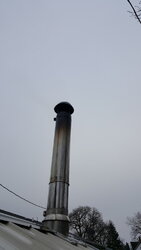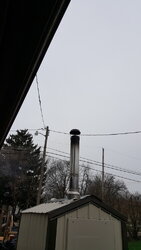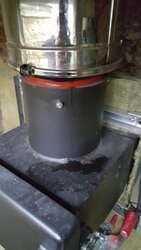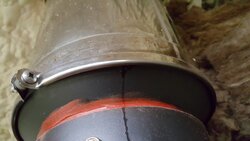I'll be ordering a grundfoss15-58 tomorrow. I checked the submittal sheets on both pumps and they are almost identical in mounting size. So that will be helpful, I should just be able to unbolt the pump I have now and install the new one with no modification.
I'm building a homemade boiler
- Thread starter warno
- Start date
-
Active since 1995, Hearth.com is THE place on the internet for free information and advice about wood stoves, pellet stoves and other energy saving equipment.
We strive to provide opinions, articles, discussions and history related to Hearth Products and in a more general sense, energy issues.
We promote the EFFICIENT, RESPONSIBLE, CLEAN and SAFE use of all fuels, whether renewable or fossil.
You are using an out of date browser. It may not display this or other websites correctly.
You should upgrade or use an alternative browser.
You should upgrade or use an alternative browser.
- Status
- Not open for further replies.
I just got done fixing, hopefully, my first big "well that was stupid" moment. I just got done with my weekly clean out of the heat exchanger. And needed to load it up for the day. I decided, without thinking anything bad would happen, to burn a bunch of the small pieces of pallet scraps I had piled up. Not thinking anything about it, I loaded up the firebox with a bunch of these pieces and switched the fan back on. It smoked a bunch at first but I thought it would clean up once these pieces got going. I mean it's small pieces of pallet it should burn up fast, was my thought. Well the smoke never cleaned up the whole time the fan ran. Then again on the second fan cycle more thick smoke pouring from chimney pipe. So much so that my wife said "that's not good, you should do something about that before some calls the cops".
So I go out with shovel in hand to unload what I had just stuffed in the fire box. I pull my ash dump container over and start shoveling out the fire box and dumping the flaming wood pieces in the dump bin. Naturally it starts burning out of control so I run it around to the side of the house with the hose and put the fire out. Go back to the firebox to unload more. Well every time I dig more out the hotter it starts burning. Not thinking about the water temps until I hear a big bubble hit my over flow pipe and start dumping water out. So I shut the fire box door to kill the blaze and check my water temps. I'm at 191 , so I go in the garage and crank the thermostat up to 90. Real quick I opened the firebox door to stir the remaining pieces around so they will burn then I shut everything up.
, so I go in the garage and crank the thermostat up to 90. Real quick I opened the firebox door to stir the remaining pieces around so they will burn then I shut everything up.
Lesson learned, don't pile the firebox full of scrap pallet pieces.
I guess I'll be cleaning the HX again tomorrow, I'm sure.



So I go out with shovel in hand to unload what I had just stuffed in the fire box. I pull my ash dump container over and start shoveling out the fire box and dumping the flaming wood pieces in the dump bin. Naturally it starts burning out of control so I run it around to the side of the house with the hose and put the fire out. Go back to the firebox to unload more. Well every time I dig more out the hotter it starts burning. Not thinking about the water temps until I hear a big bubble hit my over flow pipe and start dumping water out. So I shut the fire box door to kill the blaze and check my water temps. I'm at 191
 , so I go in the garage and crank the thermostat up to 90. Real quick I opened the firebox door to stir the remaining pieces around so they will burn then I shut everything up.
, so I go in the garage and crank the thermostat up to 90. Real quick I opened the firebox door to stir the remaining pieces around so they will burn then I shut everything up. Lesson learned, don't pile the firebox full of scrap pallet pieces.
I guess I'll be cleaning the HX again tomorrow, I'm sure.



TCaldwell
Minister of Fire
I think most of us here would admit to a or several moments like that. Actually aside from all the trouble it was a good lesson learned,
burn on man!
burn on man!
It was pretty bad today. I should have known it wasn't going to get better when the fan shut down and it was still smoking really bad. Or The brownish black smoke pouring from the chimney could have been an indicator. Usually it only smokes a few minutes after a load up then it really clears out. Not the case here. I'm still smelling the camp fire smell in my nose now.
OH_Varmntr
Burning Hunk
Yep, those moments will happen. Twice now I have had remnants of dead birds that get into my firebox get stuck in my draft door and keep it from closing.
It's not a good feeling when you look at your digital water temp readout and it's 211 degrees. Come to find out, 211 is the most the display will read. It was much hotter than that.
So hot that the circulator cavitated and would not prime because it would flash the water on the suction side of the circulator.
I hate birds.
It's not a good feeling when you look at your digital water temp readout and it's 211 degrees. Come to find out, 211 is the most the display will read. It was much hotter than that.
So hot that the circulator cavitated and would not prime because it would flash the water on the suction side of the circulator.
I hate birds.
This was the closest I have been to the "run away" situation as far as fire getting too hot. I always second guess myself leaving for work or going to bed "did I shut the door on the boiler?". I'm sure I will come home or get up one day after its happened.
OH_Varmntr
Burning Hunk
I've left home with those,thoughts as well. It becomes so routine during the winter months that I'm oftentimes not even paying attention when loading in the mornings. It'd be easy to do.
brenndatomu
Minister of Fire
Yah, and it is "double your pleasure double your fun" when your burner is in the house...little harder to walk away with the door open though I suppose. Still easy to second guess if you turned the air control down or not though. Thats when you feel a little better knowin everything is installed properly and "to code", it should take a "DUH!" moment with no catastrophes.I've left home with those,thoughts as well. It becomes so routine during the winter months that I'm oftentimes not even paying attention when loading in the mornings. It'd be easy to do.
This is kinda like when your are driving and thinking about stuff, all of a sudden you think "did I stop at that last intersection?!"
Or "was that last light green or red?!"

I've started to wonder if my chimney cap needs some renovation. It seems the sometimes my cap causes the smoke to drive back down instead of getting out of the way. It basically looks like a upside down pie pan. I wondering if just a flat plate would be better. Or maybe it needs more height off the chimney opening. Its about 6" off the top of the chimney.
Could anyone help me out here?
Here's some pictures of what I have.


Could anyone help me out here?
Here's some pictures of what I have.


hondaracer2oo4
Feeling the Heat
Mostly depends on the weather. When you get that inversion the smoke just wants to leave the chimney and hug the ground.
maple1
Minister of Fire
I can't see anything much wrong looking about that cap. Lots of airspace under it, and most factory caps are more restrcitive looking than that. I think.
Fred61
Minister of Fire
Cold smoke (low stack temp) is more likely to fall but the problem is usually caused by the weather. Inversions are unusual here but common in many places due to the geography but this year we have had more than our share of the phenomenon.
Another chimney question, after the abundance of rain we got today there was a little stream of water running out from inside the outter wall of the chimney. How could this be happening? Anyway to seal it up so it's not a problem anymore? I noticed on the last rain we had as well.
Here's some pictures


Here's some pictures


Fred61
Minister of Fire
That shouldn't be happening. How many sections do you have? Is there a vent between the walls that is exposed to the weather on the top section under your cap?
maple1
Minister of Fire
My sections lock to each other. Sit one on top of the other, rotate a little bit & it's there. I think most are like that - the bands are to help keep it there. My factory cap also fastens the same way - so the top edge of the top pipe is protected from the weather. Not sure how yours is up there?
I plumbed in my new grundfoss 15-58 and my water hammer arrestor yesterday. The pump seems to be working better then the other. It took alittle bit longer to pull prime then I would have liked but it was running good after that. The water hammer arrestor I assume works but haven't needed to shut down my pump yet to test it. We'll see if this fixes the problem of the cavitation.
I've been kicking around the idea of a new blower fan for my boiler. I have 2 in mind but I'm not sure how much CFM I need to run. The 2 I'm looking at are either 165 CFM or 250 CFM. What I'm running now, im guessing, is around 75 CFM. Is there any calculations that can be done to give me a rough number on a blower fan CFM I could use?
TCaldwell
Minister of Fire
It's a difficult call, those cfm ratings are based on data that won't really correlate to your conditions. Unless you know how many cfm you are actually currently inducing through your boiler vs. rated motor cfm, you won't know with any certainty. The best you could assume would be if the new motor is rated for more than the current one at the same rpm then you probably have more cfm. That's why I'd suggest a fractional 3 ph and a vfd, then you could tune your boiler, experimenting with different wood types/ fan speeds.
I'm looking into a new fan with a variable speed now.
But I now I'm wondering if I should be concerned about the sounds I'm hearing while my boiler fan is running. It sounds like the water is literally boiling off the heat exchanger and firebox inside the water jacket. There's a float switch that shuts everything down if the water gets to low. So I know that everything is submerged in the water. I'm finding it hard to believe that its actually hot enough to be boiling.
If you listen to this video you can hear a sizzling sound. Don't mind my struggle opening the door I'm right handed trying to use my left hand on the latch.
Also with that same fire in the video I'm getting a fair amount blue smoke from the chimney with nothing but coals burning in the firebox. Could this be from a dirty chimney? I need to get it cleaned but haven't had the time with the holidays.
So I'm new questions are
What is that sizzling sound?
Could a dirty chimney Cause smoke with a hot burn?
But I now I'm wondering if I should be concerned about the sounds I'm hearing while my boiler fan is running. It sounds like the water is literally boiling off the heat exchanger and firebox inside the water jacket. There's a float switch that shuts everything down if the water gets to low. So I know that everything is submerged in the water. I'm finding it hard to believe that its actually hot enough to be boiling.
If you listen to this video you can hear a sizzling sound. Don't mind my struggle opening the door I'm right handed trying to use my left hand on the latch.
Also with that same fire in the video I'm getting a fair amount blue smoke from the chimney with nothing but coals burning in the firebox. Could this be from a dirty chimney? I need to get it cleaned but haven't had the time with the holidays.
So I'm new questions are
What is that sizzling sound?
Could a dirty chimney Cause smoke with a hot burn?
Last edited:
maple1
Minister of Fire
I couldn't pick out the sizzling sound you mentioned.
But some boilers will 'kettle' in certain conditions. I think it's the way water flows internally in the boiler, or more like doesn't flow in certain spots or cavities or 'dead flow' areas inside. Like eddies in a stream. I don't think I'd describe it as a sizzle, sounds sorta just like you'd imagine boiling would sound inside. Maybe reduced flow from the new pump is now highlighting these spots?
I forget - do you have a bypass loop on the boiler? If not, adding one might help. My old wood/oil unit did, it had another circ in it that would come on at a certain temp (forget the temp now). I think I was told it was there to prevent boiler shock, but it would make more flow through the boiler and maybe stop a kettling condition. If that's what's happening.
But some boilers will 'kettle' in certain conditions. I think it's the way water flows internally in the boiler, or more like doesn't flow in certain spots or cavities or 'dead flow' areas inside. Like eddies in a stream. I don't think I'd describe it as a sizzle, sounds sorta just like you'd imagine boiling would sound inside. Maybe reduced flow from the new pump is now highlighting these spots?
I forget - do you have a bypass loop on the boiler? If not, adding one might help. My old wood/oil unit did, it had another circ in it that would come on at a certain temp (forget the temp now). I think I was told it was there to prevent boiler shock, but it would make more flow through the boiler and maybe stop a kettling condition. If that's what's happening.
- Status
- Not open for further replies.
Similar threads
- Replies
- 20
- Views
- 823
- Replies
- 10
- Views
- 1K
- Replies
- 2
- Views
- 256
- Replies
- 4
- Views
- 896

